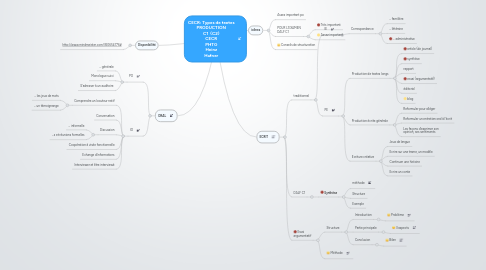
1. ORAL
1.1. PO
1.1.1. ... générale
1.1.2. Monologue suivi
1.1.3. S'adresser à un auditoire
1.2. IO
1.2.1. Comprendre un locuteur natif
1.2.1.1. ... les jeux de mots
1.2.1.2. ... un témoignange
1.2.2. Conversation
1.2.3. Discussion
1.2.3.1. ... informelle
1.2.3.2. ...s et réunions formelles
1.2.4. Coopération à visée fonctionnelle
1.2.5. Echange d'informations
1.2.6. Interviewer et être interviewé
2. Disponibilité
2.1. http://www.mindmeister.com/350654776#
3. ECRIT
3.1. traditionnel
3.1.1. IE
3.1.1.1. Correspondance
3.1.1.1.1. ... familière
3.1.1.1.2. ... littéraire
3.1.1.1.3. ... administrative
3.1.2. PE
3.1.2.1. Production de textes longs
3.1.2.1.1. article (de journal)
3.1.2.1.2. synthèse
3.1.2.1.3. rapport
3.1.2.1.4. essai (argumentatif)
3.1.2.1.5. éditorial
3.1.2.1.6. blog
3.1.2.2. Production écrite générale
3.1.2.2.1. Reformuler pour alléger
3.1.2.2.2. Reformuler un entretien oral à l'écrit
3.1.2.2.3. Les façons d'exprimer son opinion, ses sentiments
3.1.2.3. Ecriture créative
3.1.2.3.1. Jeux de langue
3.1.2.3.2. Ecrire sur une trame, un modèle
3.1.2.3.3. Continuer une histoire
3.1.2.3.4. Ecrire un conte
3.2. DALF C1
3.2.1. Synthèse
3.2.1.1. méthode
3.2.1.2. Structure
3.2.1.3. Exemple
3.3. Essai argumentatif
3.3.1. Structure
3.3.1.1. Introduction
3.3.1.1.1. Problème
3.3.1.2. Partie principale
3.3.1.2.1. 3 aspects
3.3.1.3. Conclusion
3.3.1.3.1. Bilan
3.3.2. Méthode
4. icônes
4.1. Assez important po
4.2. POUR L'EXAMEN DALF C1
4.2.1. Très important
4.2.2. Assez important
